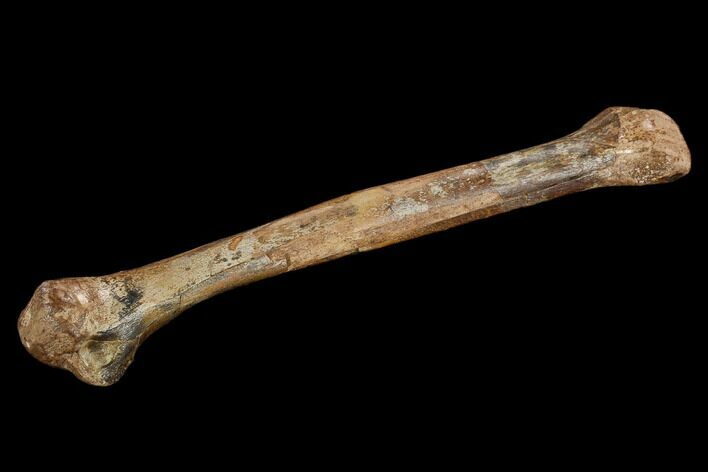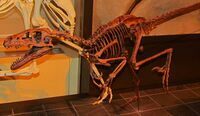This Specimen has been sold.
8" Raptor Phalange - Judith River Formation, Montana
This is an 8.0" long fossil phalange (finger bone) of a theropod dinosaur, from the Judith River Formation of Montana. It is lacking the diagnostic markers to determine exactly which theropod species it belongs to. Using size as an indictor it is most likely that this bone is from Dromaeosaur (aka raptor). It is likely the first phalange of the third finger on the right hand.
Both of the ends have been restored which is reflected in the price.
Both of the ends have been restored which is reflected in the price.
Dromaeosaurus
was a small genus of meat-eating dinosaurs (raptors) that ripped flesh with its sickle claws and pulverized bones with a powerful bite. Its toothy grasp was suspected to be nearly three times as powerful as that of Velociraptor.
Dromaeosaurus lived during the Late Cretaceous period, sometime between 76.5 and 74.8 million years ago in the western United States and Alberta, Canada. Fossil teeth dated to 65.5 million years old may possibly belong to the genus, though these teeth are one of many mysteries that surround Dromaesaurus.
This little beastie’s name means 'running lizard'. Dromaeosaurus was a small carnivore, about 2 meters (6 feet 7 inches) in length, 15 kilograms (33 pounds) in weight, and stood 1.5 feet tall at the hips. It darted around in a world of other small theropods, ceratopsians, ankylosaurs, 30-foot hadrosaurs, and both small and massive tyrannosauroids.
The sediments they are found in select against the preservation of small theropods. Consequently, little is known about their lifestyle except what can be gleaned from the stories that their teeth reveal. We do know that they frequently shed teeth as they attacked and frenzied over their meals.
The genus is likely related to Utahraptor, as evidenced by its deadly toe claw on each foot. Dromaeosaurus varies from its relatives in some traits. It has a short, massive skull, a deep mandible, and robust teeth. The teeth tend to be more heavily worn, suggesting that its jaws were used for crushing and tearing and the giant toe claw may have had other primary uses. These details support a scavenger lifestyle, but, as already mentioned, there are few absolute conclusions regarding this robust little theropod.
Dromaeosaurus lived during the Late Cretaceous period, sometime between 76.5 and 74.8 million years ago in the western United States and Alberta, Canada. Fossil teeth dated to 65.5 million years old may possibly belong to the genus, though these teeth are one of many mysteries that surround Dromaesaurus.
This little beastie’s name means 'running lizard'. Dromaeosaurus was a small carnivore, about 2 meters (6 feet 7 inches) in length, 15 kilograms (33 pounds) in weight, and stood 1.5 feet tall at the hips. It darted around in a world of other small theropods, ceratopsians, ankylosaurs, 30-foot hadrosaurs, and both small and massive tyrannosauroids.
The sediments they are found in select against the preservation of small theropods. Consequently, little is known about their lifestyle except what can be gleaned from the stories that their teeth reveal. We do know that they frequently shed teeth as they attacked and frenzied over their meals.
The genus is likely related to Utahraptor, as evidenced by its deadly toe claw on each foot. Dromaeosaurus varies from its relatives in some traits. It has a short, massive skull, a deep mandible, and robust teeth. The teeth tend to be more heavily worn, suggesting that its jaws were used for crushing and tearing and the giant toe claw may have had other primary uses. These details support a scavenger lifestyle, but, as already mentioned, there are few absolute conclusions regarding this robust little theropod.
SPECIES
Sub Order Theropoda
LOCATION
Hill County, Montana
FORMATION
Judith River Formation
SIZE
8.0"
CATEGORY
SUB CATEGORY
ITEM
#121226
We guarantee the authenticity of all of our specimens.
 Reviews
Reviews














